What the ... ? Take 1
I hope everyone had an enjoyable Fourth of July holiday! I was at Edisto Beach for the holiday and, boy, was the beach packed. Just look at the people at the fireworks show at the town park!
Don’t try to look for me in the crowd. If I was amongst the masses, looking for me would be infinitely harder than looking for Waldo. In fact, I wasn’t in the crowd. You seriously think I’m crazy enough to pack in with everybody like sand-, lotion-, DEET- and sweat-covered sardines?

No, sir, I got a better place to be on this tropical, 90-plus-degree Fourth of July evening—my porch with a cold brew.
Under the stairs to the porch is a bush of lantana with a lone redbay sapling growing among the lantanas. I’m the sentimental sort that doesn’t want to get rid of the redbay sapling because I hope it'll grow up, mature and repopulate the entire island. The Mother of All Recovering Redbay Trees! If y’all ask my wife, you’ll likely get the truth—I’m just too lazy to cut it until I absolutely must (such as when the sapling becomes something big enough to grow through the stairs).
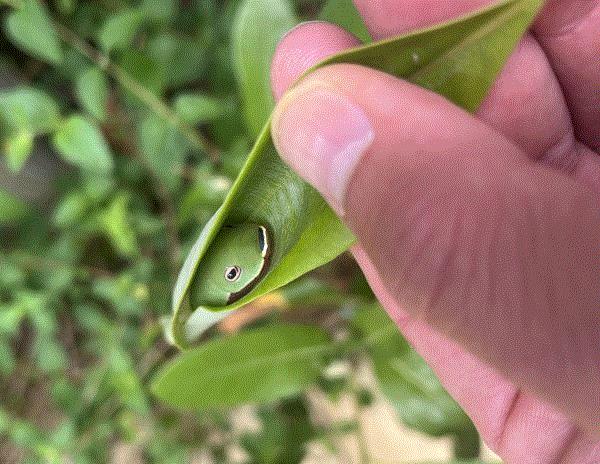
The redbay sapling is serving a very important ecological function at this moment. I noticed one of the leaves was rolled up. I peeked into it and something was staring back.
What in the world was that?

What the ... ? Take 2
Aaron Palmateer, a Director of Agronomy at Harrell’s, and I have a mutualistic relationship, I think. Not simply because Aaron and I had a very similar career path that led from the ivory tower to the private industry. Aaron is my go-to plant pathologist for many disease diagnoses and questions, and I serve the same role for him in terms of entomological head-scratchers. This relationship is built over years of knowing and running into each other on the speaking circus and collaborating on various research projects.
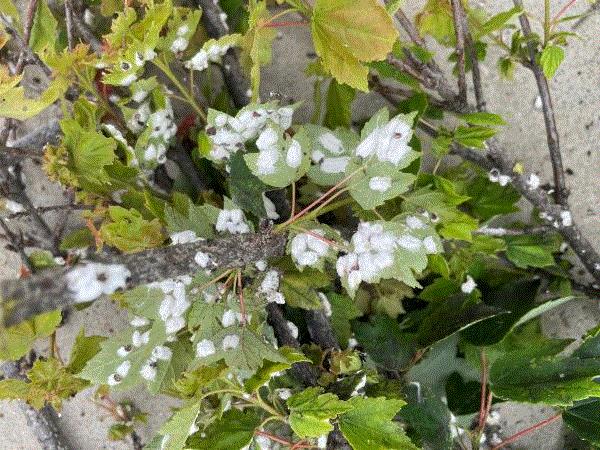
About a month ago, Aaron sent me a picture showing a multitude of white, fluffy balls under maple leaves. There are also many greyish creatures on the stems of the maple tree.
What might they be?
Harrell's Introduces Azo Root
In late April, Harrell’s has introduced Azo Root, a new biological product containing a plant growth promoting bacterium Azospirillum brasilense. This product is for use on turf, trees, shrubs, vegetables, flowers and other ornamental crops. Last week, Aaron wrote a blog post on how Azo Root could be used in horticulture. I’ll summarize a few main takeaways here.
Azospirillum brasilense isn’t new—it's been used to promote root growth and plant health in agriculture for many years. I did some quick literature research and found quite a few studies (many from South America where the bacterium originated) documenting the benefits for agronomic crops.

The root-promoting benefit is possible because this bacterium produces the growth hormone indole-3-acetic acid (IAA). In addition to promoting root growth, A. brasilense is also able to fix nitrogen and so works like a biological fertilizer. It’s different from other host-specific nitrogen, fixing bacteria by being compatible with many plant species. As a plant health promoter, Azo Root helps plants tolerate environmental stresses, such as drought and temperature extremes.
On-site trials in cocoplum and podocarpus propagation have shown very good results. A single application of Azo Root shortened the duration of liner production by as much as two weeks compared to the grower’s standard. Aaron also let me in on a recent trial that showed faster rooting of 1-gal. Green Giant Boxwood.

A demonstration of the root-promoting benefit of Azo Root in cocoplum liner production. (Photo credit: Harrell's.)
Paul Giordano, also a Director of Agronomy at Harrell’s, told me that the key to the efficacy and benefits of Azo Root comes down to its “on-demand” Live-Microbe brewing and packaging innovation from 3Bar Biologics. I also thought the packaging technology, which I haven’t seen before, is an interesting way to make sure you have a long shelf life while delivering a fresh batch of the bacteria.
Here's how it works: Azo Root comes with a cap containing freeze-dried bacteria, allowing the product to be viable for nine months from the date of manufacture when stored properly. Along with the cap is a container filled with fermentation medium. You twist the cap, drop the freeze-dried bacteria into the fermentation medium (without opening the cap), shake them well, then let them grow in the medium for 72 hours. This package allows the bacterial culture to grow uncontaminated and to reach peak concentration. After the brewing period, you pour everything from one package into the spray tank, dilute (in a minimum of 100 gal. of water) and spray (to 1 acre).
Go HERE for a YouTube video of how to prepare Azo Root for spraying.
So how is this Azo Root different from Obtego and Rootshield Plus, you ask? Aaron indicated that A. brasilense isn’t a mycoparasite like Trichoderma bacteria in Obtego and RootShield Plus—that means Azo Root likely doesn’t have biofungicidal activity. It’s used strictly as a root growth promoter, biofertilizer and plant health promoter.
Go HERE for a blog post from Aaron on how Azo Root works in horticulture. Go HERE for label and other information on Azo Root.

Answer to “What the … ?” Take 2 First
I’ll reveal the answer to the second “What the … ?” mystery before the first mystery.
The cotton balls under the maple leaves aren’t some kind of disease—it’s actually the ovisacs or egg sacs of many cottony maple leaf scale. Those grey creatures on the stems were the overwintering nymphs and adult females that hadn’t move on to the leaves yet.
Okay, since you insist on being nerdy, the scientific name of the cottony maple leaf scale is Pulvinaria acericola. This is a very common soft scale species, often found attacking maples, but I’ve frequently found them on dogwoods and hollies. Other host plants include Japanese andromeda, tupelo, sassafras and redbay. (Seriously, I didn’t plan the redbay connection here.) Attacks are more common in landscapes, but I’ve seen infestations of nursery stocks that had been held on for too long.
Don’t confuse the cottony maple leaf scale with its close cousin, the cottony maple scale. If you say, “What? The names are almost the same!” I’ll say, “Yes! Precisely why we have scientific names! And, of course, naming something with a dead language also makes us look smart and authoritative.”
The cottony maple scale, Neopulvinaria innumerabilis (used to be called Pulvinaria innumerabilis in older literature), looks very similar to the cottony maple leaf scale, the star of today’s mystery show. They’re distributed in about the same areas and produce white, fluffy egg sacs at about the same time. But they’re quite easy to tell apart—the egg sacs of the cottony maple scale are on the stems and the egg sacs of the cottony maple leaf scale are on the underside of leaves. Easy!
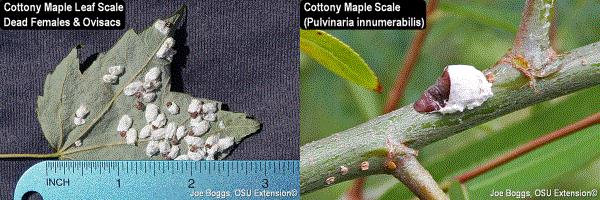
A comparison of the cottony maple leaf scale (left) and the cottony maple scale (right). It's easy to tell them apart: A cottony maple leaf scale produces egg sacs on the underside of a leaf, but a cottony maple scale produces eggs on the stem. (Photo credit: Joe Boggs, The Ohio State University Extension.)
Each egg sac contains 1,500 to 2,500 eggs. The eggs hatch around late May in my neck of the woods. Joe Boggs of the Onio State University Extension noted that, in Ohio, egg hatch begins around 1,216 growing degree-days and when golden rain tree is at full bloom. Go HERE for Joe’s article, which has lots of great pictures of this pest, including monitoring crawler emergence with a sticky tape or band.

How do you manage cottony maple leaf scales?
Severe infestation by cottony maple leaf scales can lead to branch dieback and lots of sooty mold. I found sprays of a tank mix of horticultural oil (2%) and an insect growth regulator during and after crawler emergence is a very effective way of reducing the population. There are two effective insect growth regulators—buprofezin (or Talus) and pyriproxyfen (or Distance). Pick either one of these or rotate them.
You’ll likely have to make at least two applications, two weeks apart, to cover the entire crawler emerging period. In addition to being effective, Talus and Distance are compatible with most ladybeetles and other predators and parasitoids attacking the scale insects. If you spray, make sure you direct the spray to the underside of leaves where the crawlers congregate and feed.
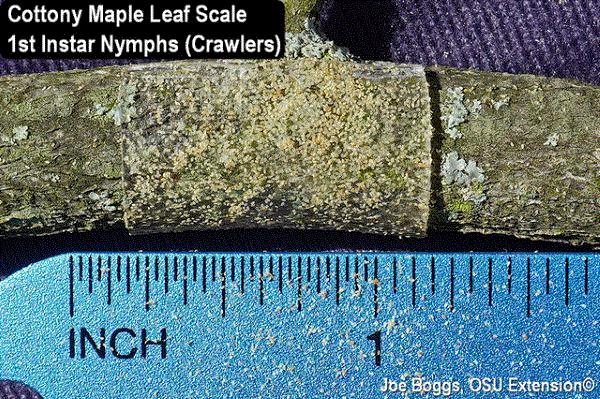
Use a stick band to trap and monitor the activity of scale insect crawlers. This will help you decide when it's time to spray. (Photo credit: Joe Boggs, The Ohio State University Extension.)
Of course, spraying won’t be an option for tall trees, even if you have a cherry picker. This is when drenching, injecting or doing a basal trunk spray of systemic insecticides comes in handy. Crawlers of cottony maple leaf scale (and those of many other soft scale species, including the cottony maple scale) move out of the egg sacs and feed under the leaves, where they ingest the systemic insecticide applied to the roots or trunks.
My previous research showed systemic application was a very effective way of managing scale insects. My go-to systemic insecticides for use in this indirect manner are neonicotinoids with dinotefuran (Safari) being the most effective. If you're wary of using or don’t want to use neonicotinoids, the other options would be flupyradifurone (Altus) and spirotetramat (Kontos).
This management approach for the cottony maple leaf scale should also be effective against other scale insects that feed on leaves or their crawlers that feed on leaves. Best of luck in managing any scale insect you come to deal with this summer!
Go HERE for a review article I co-authored with my then Ph.D. student Ernesto Robayo Camacho on the biology and management of soft scales. I think the table on the known degree-day models and plant phenological indicator plant species is particularly useful.
Go HERE to revisit the 2022 version of GrowerTalks’ Insecticide, Miticide & Fungicide Guide, where I shared my experience with managing mealybugs and scale insects.

Answer to “What the … ? Take One”
Okay, let’s finally circle back to the answer for the peeking creature ...
Staring back at me was a fully grown or fifth-instar caterpillar of Palamedes swallowtail. I don’t blame you if you think it’s a snake of some kind. That’s what my wife thought when I showed her the picture. If she can tolerate finding random dead bugs in the freezer, I can reciprocate by not reproaching her entomological ignorance.
What seemed to be staring back weren’t even real eyes—those are eye-mimicking spots or false eyes that start to appear at the second instar of many swallowtail species. Their purpose is to scare a potential predator (and you) away, thinking that your busy hands have roused a snake. This scare is perhaps exacerbated by the fifth-instar caterpillar’s habit of folding and tying a leaf for concealment.
Caterpillars of many swallowtail species employ mimicry and chemical warfare to ensure their survival to adulthood in this cruel world. Younger caterpillars often mimic bird or lizard poop. All larval instars have bright orange extensions from behind their heads, called osmeteria, that secrete repelling chemicals.
The Palamedes swallowtail is quite common in the coastal plains of the Southeast, from the southeastern corner of Virginia to eastern Texas. But the “common” status may have to be reassessed soon. The Palamedes swallowtail feeds only on redbay and swampbay, two native tree species that have been decimated by laurel wilt disease in the Southeast. As y’all can imagine, as a host plant population goes, so goes an insect population that’s dependent intimately on that host plant.
A study conducted by John Riggins and colleagues in Mississippi and North Carolina reported that the abundances of Palamedes swallowtails in the disease-impacted stands were on average six times lower than in the unimpacted stands.
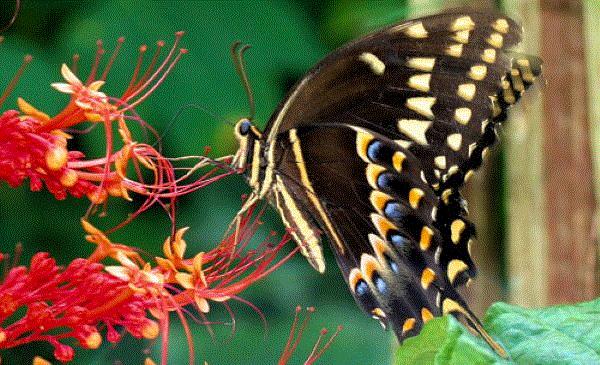
A Palamedes swallowtail sipping nectar from a pagoda flower. (Photo credit: Donald Hall, University of Florida.)
I mentioned in an earlier issue of this newsletter that laurel wilt has devastated the redbay population on Edisto Beach. I’d seen Palamedes swallowtail caterpillars only on larger redbay trees in the past; I’d not seen them feeding on a sapling before. I wonder if the swallowtails have so few host plants left on this barrier island now that they’re willing to start feeding on something smaller and less suitable, like a sapling? If I’m right, this is a distressing sign of a desperate population.
Donald Hall of the University of Florida wrote a wonderful fact sheet about the Palamedes swallowtail. The pictures included in this fact sheet illustrate the life cycle of a Palamedes swallowtail; they’re absolutely fabulous. There's also a nice pictorial comparison of a fully grown caterpillar and a squirrel tree frog; if y’all don’t see the likeness and exclaim the wonders of nature, I don’t know what will. Go HERE for the fact sheet on the Palamedes swallowtail.
Now that she knows the importance of the little redbay sapling, and in the interest of avoiding an ecological disaster, my wife has agreed to my plan of kicking the sapling-cutting can down the road.
I think you’re mistaken ... that isn’t a I-totally-got-what-I-wanted smirk on my face ...



See y'all later!

JC Chong
Technical Development Manager at SePRO
Adjunct Professor at Clemson University
This e-mail received by 27,847 subscribers like you!
If you're interested in advertising on PestTalks contact Kim Brown ASAP!